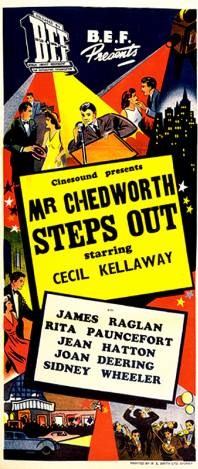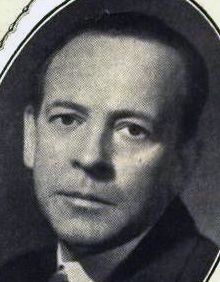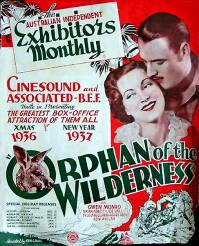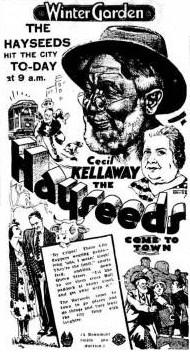Related Research Articles

Kenneth George Hall was an Australian film producer and director, considered one of the most important figures in the history of the Australian film industry. He was the first Australian to win an Academy Award.

Cinesound Productions Pty Ltd was an Australian feature film production company. Established in June 1931, Cinesound developed out of a group of companies centred on Greater Union Theatres that covered all facets of the film process, from production to distribution and exhibition. Cinesound Productions established a film studio as a subsidiary of Greater Union Theatres Pty Ltd based on the Hollywood model. The first production was On Our Selection (1932), which was an enormous financial success.

Shirley Ann Richards was an Australian actress and author who achieved notability in a series of 1930s Australian films for Ken G. Hall before moving to the United States, where she continued her career as a film actress, mainly as a Metro-Goldwyn-Mayer starlet. Her best known performances were in It Isn't Done (1937), Dad and Dave Come to Town (1938), An American Romance (1944), and Sorry, Wrong Number (1948). In the 1930s, she was the only Australian actor under a long-term contract to a film studio, Cinesound Productions. She subsequently became a lecturer and poet.

Mr. Chedworth Steps Out is a 1939 Australian comedy film directed by Ken G. Hall starring Cecil Kellaway. Kellaway returned to Australia from Hollywood to make the film, which features an early screen appearance by Peter Finch.

Frank Harvey was a British-born actor, producer, and writer, best known for his work in Australia.
The Silence of Dean Maitland is a 1934 Australian film directed by Ken G. Hall, and based on Maxwell Gray's 1886 novel of the same name. It was one of the most popular Australian films of the 1930s.

Thoroughbred is a 1936 Australian race-horse drama film directed by Ken G. Hall, partly based on the life and career of Phar Lap. Hollywood star Helen Twelvetrees was imported to Australia to appear in the film. The film also stars Frank Leighton and John Longden.

Orphan of the Wilderness is a 1936 Australian feature film from director Ken G. Hall about the adventures of a boxing kangaroo. It starred Brian Abbot who disappeared at sea not long after filming completed.
It Isn't Done is a 1937 Australian comedy film about a grazier who inherits a barony in England.

Lovers and Luggers is a 1937 Australian film directed by Ken G. Hall. It is an adventure melodrama about a pianist who goes to Thursday Island to retrieve a valuable pearl.
Tall Timbers is a 1937 action melodrama set in the timber industry directed by Ken G. Hall and starring Frank Leighton and Shirley Ann Richards.
Come Up Smiling is a 1939 Australian comedy film starring popular American stage comedian Will Mahoney and his wife Evie Hayes. It was the only feature from Cinesound Productions not directed by Ken G. Hall.

Francis William Thring III, better known as F. W. Thring, was an Australian film director, producer, and exhibitor. He has been credited with the invention of the clapperboard.

The Hayseeds is a 1933 Australian musical comedy from Beaumont Smith. It centres on the rural family, the Hayseeds, about whom Smith had previously made six silent films, starting with Our Friends, the Hayseeds (1917). He retired from directing in 1925 but decided to revive the series in the wake of the box office success of On Our Selection (1932). It was the first starring role in a movie for stage actor Cecil Kellaway.
White Death is a 1936 Australian film directed by Edwin G. Bowen and starring Zane Grey as himself. He filmed it during a fishing expedition to Australia and it marked the first time he had played a leading role in a film.
Sheepmates was a proposed Australian film from director F. W. Thring based on a 1931 novel by William Hatfield. It commenced filming in 1933 but was abandoned.
The Man They Could Not Hang is a 1934 Australian film directed by Raymond Longford about the life of John Babbacombe Lee, whose story had been filmed previously in 1912 and 1921. These silent films were called "one of the greatest box-office features that ever came out of this country." The sound film was not as successful.
The Adorable Outcast is a 1928 Australian silent film directed by Norman Dawn about an adventurer who romances an island girl. The script was based on Beatrice Grimshaw's novel Conn of the Coral Seas. It was one of the most expensive films made in Australia until that time, and was Dawn's follow up to For the Term of His Natural Life (1927). It did not perform as well at the box office and helped cause Australasian Films to abandon feature film production.
Tall Timber is a 1926 Australian silent film about a rich man who flees the city and works in a timber mill. It is considered a lost film.
William Hatfield (1892–1969) was the pen name of Ernest Chapman, an English-born writer best known for his work in Australia.
References
- ↑ ""HERALD'S" NEW SERIAL". The Sydney Morning Herald . No. 30, 620. New South Wales, Australia. 22 February 1936. p. 11. Retrieved 8 March 2024– via National Library of Australia.
- ↑ Geoffrey Serle, 'Hatfield, William (1892–1969)', Australian Dictionary of Biography, National Centre of Biography, Australian National University, https://adb.anu.edu.au/biography/hatfield-william-6598/text11359, published first in hardcopy 1983, accessed online 8 March 2024.
- ↑ "BIG TIMBER". The Sydney Morning Herald . No. 30, 622. New South Wales, Australia. 25 February 1936. p. 4. Retrieved 8 March 2024– via National Library of Australia.
- ↑ Hatfield, William (18 November 1936). ""Reviewed Briefly"". The Bulletin. p. 4. Retrieved 18 April 2024.
- ↑ "TO SEE HITLER AND MUSSOLINI". The Daily Telegraph. Vol. II, no. 167. New South Wales, Australia. 2 October 1937. p. 3. Retrieved 8 March 2024– via National Library of Australia.
- ↑ "Ten New Australian Films". The Argus (Melbourne) . No. 27, 833. Victoria, Australia. 2 November 1935. p. 26. Retrieved 8 March 2024– via National Library of Australia.
- ↑ "Notes on the Screen". The Argus (Melbourne) . No. 27, 836. Victoria, Australia. 6 November 1935. p. 10. Retrieved 8 March 2024– via National Library of Australia.
- ↑ Hatfield, William (30 October 1935). ""Cinesound Plans Reveal 14 Features for 1936 Production U.S. DIRECTOR FOR FOUR OUTDOOR SUBJECTS: KEN G. HALL STARTS FIRST DECEMBER 1."". Everyones. p. 5. Retrieved 18 April 2024.